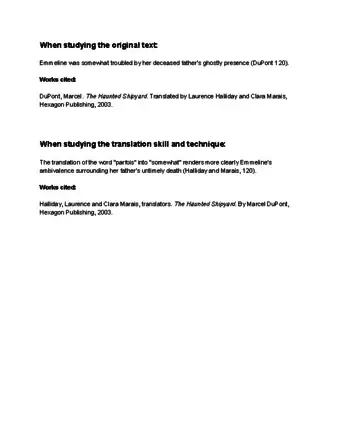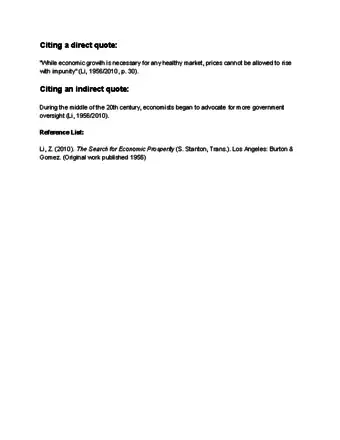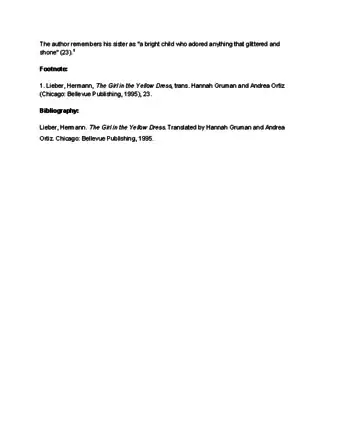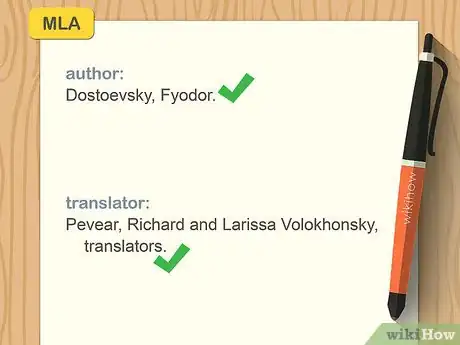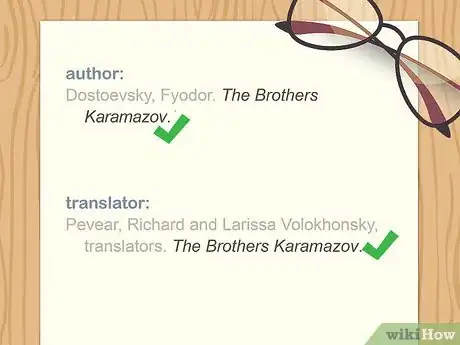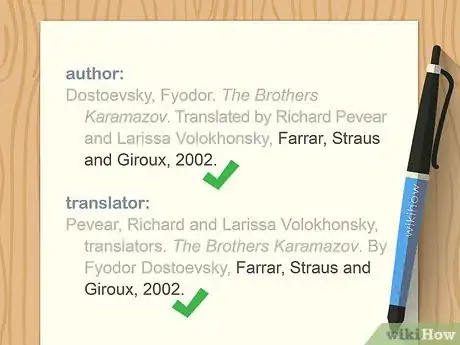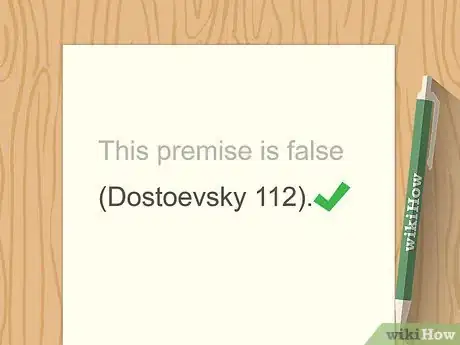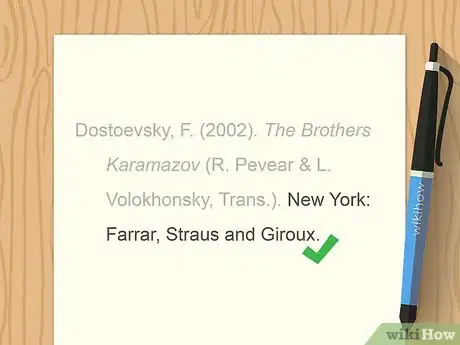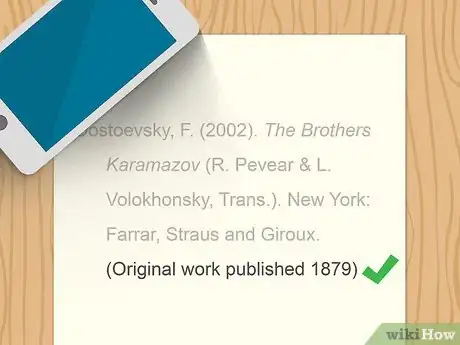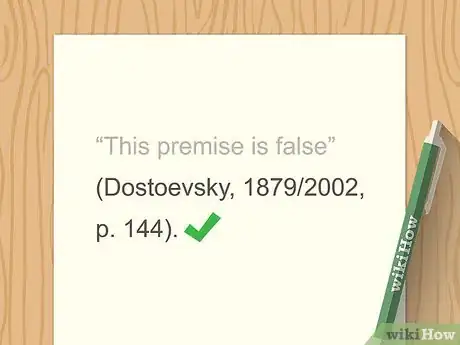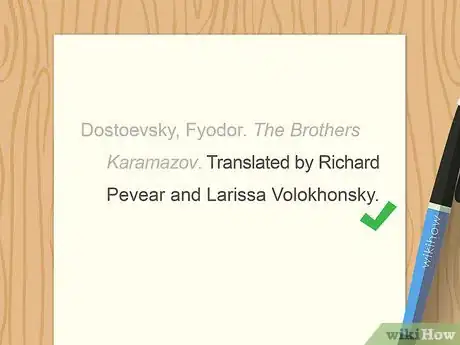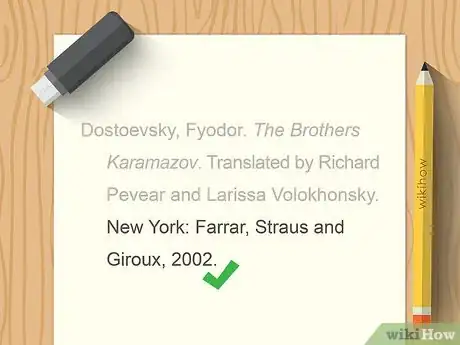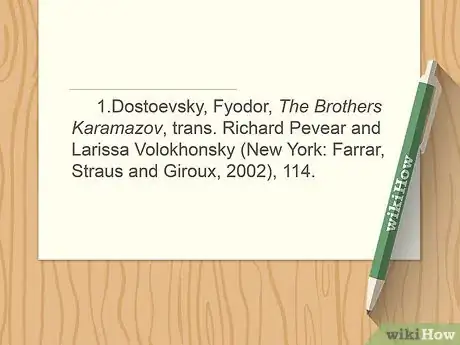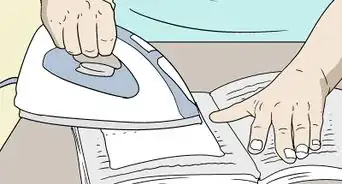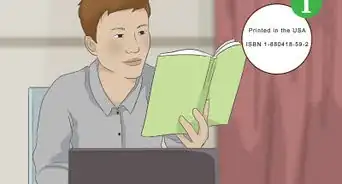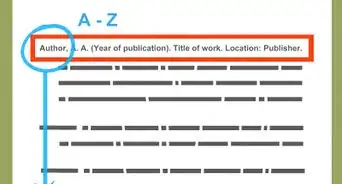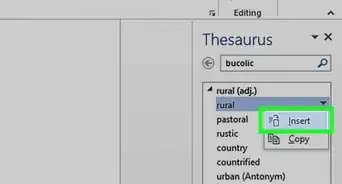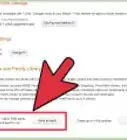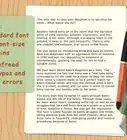This article was co-authored by wikiHow staff writer, Jennifer Mueller, JD. Jennifer Mueller is a wikiHow Content Creator. She specializes in reviewing, fact-checking, and evaluating wikiHow's content to ensure thoroughness and accuracy. Jennifer holds a JD from Indiana University Maurer School of Law in 2006.
This article has been viewed 60,689 times.
Learn more...
If a work was originally published in an unfamiliar language, you may only be able to read it by using a later translation. When referencing a translated book in a research paper or report, you generally need to list both the original author and the translator in your citation. The format for doing this varies depending on whether you're using the Modern Language Association (MLA), American Psychological Association (APA), or Chicago citation style.
Steps
Sample Citations
MLA
-
1Start with either the author or translator. If you're using the text of the book, list the original author first. If you're studying translation skill and technique, list the translator first. Type the last name, then a comma, then the first name. Place a period after the name.[1]
- Original author example: Dostoevsky, Fyodor.
- Translator example: Pevear, Richard and Larissa Volokhonsky, translators.
-
2Provide the title of the book in italics. After the name, type the translated title of the book and any subtitle. Use title case, capitalizing nouns, pronouns, adjectives, verbs, and adverbs. Place a period after the title.[2]
- Original author example: Dostoevsky, Fyodor. The Brothers Karamazov.
- Translator example: Pevear, Richard and Larissa Volokhonsky, translators. The Brothers Karamazov.
Advertisement -
3Add the name you didn't put first. After the title, list the translator's name if you started your citation with the original author's name. If you listed the translator's name first, provide the name of the original author. Place a comma after the name.[3]
- Original author example: Dostoevsky, Fyodor. The Brothers Karamazov. Translated by Richard Pevear and Larissa Volokhonsky,
- Translator example: Pevear, Richard and Larissa Volokhonsky, translators. The Brothers Karamazov. By Fyodor Dostoevsky,
-
4Conclude with publication information. Following the comma, type the name of the publisher of the translation. Place a comma after the publisher's name, then type the year the translation was published. Place a period to close out your citation.[4]
- Original author example: Dostoevsky, Fyodor. The Brothers Karamazov. Translated by Richard Pevear and Larissa Volokhonsky, Farrar, Straus and Giroux, 2002.
- Translator example: Pevear, Richard and Larissa Volokhonsky, translators. The Brothers Karamazov. By Fyodor Dostoevsky, Farrar, Straus and Giroux, 2002.
-
5Use the name you put first in parenthetical citations. Your in-text citation is meant to direct your reader to the full citation in your "Works Cited." If you listed the translator first, your parenthetical should have the name of the translator along with the page number for the material you're citing. If you have the original author's name first in your "Works Cited" entry, use their name in your parenthetical citation as well.[5]
- Original author example: (Dostoevsky 112)
- Translator example: (Pevear and Volokhonsky 112)
APA
-
1Start with the name of the original author. Type the last name of the original author, them a comma, then the author's first initial. If a middle initial is also given, you can include that as well, but it isn't necessary. The period after the initial also serves as the period to close this portion of your citation.
- Example: Dostoevsky, F.
-
2Add the year of the translation's publication. For the first year of publication, you want the year the book was published that you actually read. Place that year in parentheses after the original author's name. Put a period after the closing parentheses.
- Example: Dostoevsky, F. (2002).
-
3Provide the title of the book in italics. After the year of publication, type the title of the book using sentence-case. Only capitalize the first word of the title and any proper nouns. If the book has a subtitle, place a colon at the end of the title and then add the subtitle. Again, capitalize the first word of the subtitle and any proper nouns.
- Example: Dostoevsky, F. (2002). The Brothers Karamazov
-
4Include the name of the translator in parentheses. After the title, type a space and then type the first initial and last name of the translator in parentheses. The name of the translator should not be italicized. Place a period outside the closing parentheses.
- Example: Dostoevsky, F. (2002). The Brothers Karamazov (R. Pevear & L. Volokhonsky, Trans.).
-
5List publication information. Follow the names of the translators with the city where the book was published. Place a colon after the name of the city, then type the name of the publisher. Place a period after the name of the publisher.
- Example: Dostoevsky, F. (2002). The Brothers Karamazov (R. Pevear & L. Volokhonsky, Trans.). New York: Farrar, Straus and Giroux.
-
6Put the original publication date at the end of your citation. You should be able to find the original publication date on the back of the title page with the copyright information. In parentheses, type the phrase "Original work published" with the year.
- Example: Dostoevsky, F. (2002). The Brothers Karamazov (R. Pevear & L. Volokhonsky, Trans.). New York: Farrar, Straus and Giroux. (Original work published 1879)
-
7Include both publication years in your parenthetical citation. APA in-text citations use the last name of the author and the date of publication. For translated books, include first the original year of publication, then type a slash, and type the year the translation was published.[6]
- Example: (Dostoevsky, 1879/2002)
- If you include a direct quote, your parenthetical citation should also include a page number. For example: (Dostoevsky, 1879/2002, p. 144)
Chicago
-
1Start your bibliographic entry with the name of the original author. Type the original author's last name first, then a comma, then their first name. Place a period after the original author's first name.
- Example: Dostoevsky, Fyodor.
-
2Type the title of the book in italics. Following the original author's name, type the title of the book using title-case. Generally, this means capitalizing all nouns, pronouns, adjectives, verbs, and adverbs. Place a period at the end of the title.
- Example: Dostoevsky, Fyodor. The Brothers Karamazov.
-
3List the translator for the edition you read. Following the title of the book, type the phrase "Translated by" and then list the name of the translator, typing their first name followed by their last name. Place a period at the end of the translator's name.
- Example: Dostoevsky, Fyodor. The Brothers Karamazov. Translated by Richard Pevear and Larissa Volokhonsky.
-
4Close your citation with publication information. Type the city where the book was published, then a colon. Follow the colon with the name of the publisher. Place a comma after the publisher's name, then type the year the translated edition was published. Close your citation with a period.
- Example: Dostoevsky, Fyodor. The Brothers Karamazov. Translated by Richard Pevear and Larissa Volokhonsky. New York: Farrar, Straus and Giroux, 2002.
-
5Change the format for footnotes in text. In footnotes, the author's name is listed with their first name first. Additionally, commas are typically used to separate parts of the citation instead of periods. Publication information is placed in parentheses. the specific page number to which the footnote refers is placed after the publication information.
- Example: Dostoevsky, Fyodor, The Brothers Karamazov, trans. Richard Pevear and Larissa Volokhonsky (New York: Farrar, Straus and Giroux, 2002), 114.
Community Q&A
-
QuestionHow do you cite a translated book in APA?
 Drew Hawkins1Community AnswerStart the citation with the last name of the original author, a comma, then their first initial followed by a period. Add the year of the publication in parenthesis followed by a period. After that, put the title of the book in italics, type a space,then type the first initial and last name of the translator in parentheses followed by a period. List the publication information in the following order: the city where the book was published, place a colon after the name of the city, then type the name of the publisher, and place a period after the name of the publisher. Put the original publication date at the end of your citation and type the phrase "Original work published" with the year. Be sure to include both publication years in your parenthetical citation.
Drew Hawkins1Community AnswerStart the citation with the last name of the original author, a comma, then their first initial followed by a period. Add the year of the publication in parenthesis followed by a period. After that, put the title of the book in italics, type a space,then type the first initial and last name of the translator in parentheses followed by a period. List the publication information in the following order: the city where the book was published, place a colon after the name of the city, then type the name of the publisher, and place a period after the name of the publisher. Put the original publication date at the end of your citation and type the phrase "Original work published" with the year. Be sure to include both publication years in your parenthetical citation. -
QuestionDo you have to cite Google Translate?
 Drew Hawkins1Community AnswerGoogle Translate can be a super valuable and useful learning tool, but it isn't perfect and translations can be incorrect or not entirely accurate. Because of the potential for inaccuracies, you may not want to use Google Translate for an essay or formal document. There isn't a formal citation format for Google Translate, however, if you do use it, you could mention that you translated your original sentence either in the text itself or in parenthesis after your translation.
Drew Hawkins1Community AnswerGoogle Translate can be a super valuable and useful learning tool, but it isn't perfect and translations can be incorrect or not entirely accurate. Because of the potential for inaccuracies, you may not want to use Google Translate for an essay or formal document. There isn't a formal citation format for Google Translate, however, if you do use it, you could mention that you translated your original sentence either in the text itself or in parenthesis after your translation. -
QuestionHow do you cite a translation in MLA?
 Drew Hawkins1Community AnswerStart by writing the last name and then the first name with a comma between them. Place a period after the name. If you're using the text of the book, list the original author first. If you're studying translation skill and technique, list the translator first. Then, add the translated title of the book and any subtitle followed by a period. After the title, list the translator's name if you started your citation with the original author's name. If you listed the translator's name first, provide the name of the original author. Place a comma after the name. Finally, put the publication information: the name of the publisher of the translation, a comma after the publisher's name, then type the year the translation was published. Place a period to close out your citation.
Drew Hawkins1Community AnswerStart by writing the last name and then the first name with a comma between them. Place a period after the name. If you're using the text of the book, list the original author first. If you're studying translation skill and technique, list the translator first. Then, add the translated title of the book and any subtitle followed by a period. After the title, list the translator's name if you started your citation with the original author's name. If you listed the translator's name first, provide the name of the original author. Place a comma after the name. Finally, put the publication information: the name of the publisher of the translation, a comma after the publisher's name, then type the year the translation was published. Place a period to close out your citation.
References
- ↑ https://owl.purdue.edu/owl/research_and_citation/mla_style/mla_formatting_and_style_guide/mla_works_cited_page_books.html
- ↑ https://owl.purdue.edu/owl/research_and_citation/mla_style/mla_formatting_and_style_guide/mla_works_cited_page_books.html
- ↑ https://owl.purdue.edu/owl/research_and_citation/mla_style/mla_formatting_and_style_guide/mla_works_cited_page_books.html
- ↑ https://owl.purdue.edu/owl/research_and_citation/mla_style/mla_formatting_and_style_guide/mla_works_cited_page_books.html
- ↑ https://owl.purdue.edu/owl/research_and_citation/mla_style/mla_formatting_and_style_guide/mla_in_text_citations_the_basics.html
- ↑ http://libguides.gwumc.edu/c.php?g=27779&p=170368
About This Article
Citing a translated book is easy in the Modern Language Association style. In the body of your essay, all you need to do is put the author’s surname and the page number of any references in parenthesis at the end of the sentence. In your works cited entry, write the author’s name, starting with their surname. Add the title of the book in italics. Then, write, “Translated by,” followed by the translator’s name. After that, write the publisher and year of publication. For example, to cite Dostoevsky’s The Brothers Karamazov, you’d write, “Dostoevsky, Fyodor. The Brothers Karamazov. Translated by Richard Pevear and Larissa Volokhonsky, Farrar, Straus and Giroux, 2002.” If you’re specifically discussing translation in your essay, write the translator’s name first instead of the author’s name. For more tips, including how to cite a translated book in APA and Chicago styles, read on!
